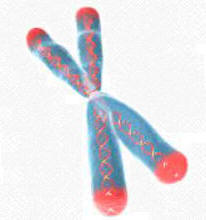News

Researchers gain new insights into chromosome shortening and identify new potential cancer drug targets
AUGUST 30, 2023
A new study has provided insights into an important biological mechanism that supports survival of aggressive, hard-to-treat cancers, and in the process, has uncovered fascinating new information about how cells divide and grow.In the new study, led by scientists at The Institute of Cancer Research and published in Nature Communications, researchers identify a new cellular role of a protein called EXD2 nuclease and, importantly, its role in the so-called ALT pathway.The study also provides potential new targets, against which cancer drugs could be developed for patients who currently have limited therapeutic options.
Researchers gain new insights into chromosome shortening and identify new potential cancer drug targets
A new study has provided insights into an important biological mechanism that supports survival of aggressive, hard-to-treat cancers, and in the process, has uncovered fascinating new information about how cells divide and grow.
In the new study, led by scientists at The Institute of Cancer Research and published in Nature Communications, researchers identify a new cellular role of a protein called EXD2 nuclease and, importantly, its role in the so-called ALT pathway.
The study also provides potential new targets, against which cancer drugs could be developed for patients who currently have limited therapeutic options.
Telomeres and the ALT pathway
ALT is short for "alternative lengthening of telomeres." Telomeres have an incredibly important function in cells. They act like a protective cap during normal cell division but shorten every time a cell divides, which makes cell death inevitable over time.
This means that to survive and proliferate, cancer cells must subvert this natural process of telomere shortening, maintaining the length of their telomeres.
They achieve this through two different mechanisms: either through activation of telomerase—an enzyme that promotes lengthening of telomeres—or via the ALT process.
The ALT pathway is known to support survival in 10% to 15% of cancers. There is very limited knowledge about how ALT works—and yet it's one of the fundamental pathways in those cancers.
Major role of EXD2 nuclease
Building on previous work that uncovered a key role for EXD2 nuclease in DNA replication, in this study the research team focused specifically on EXD2 in ALT-reliant cancers. They established that EXD2 is essential to promote telomere maintenance via a process called break-induced replication, and discovered that the loss of EXD2 in ALT cells resulted in telomere shortening.
Importantly, the study also found that EXD2 depletion killed ALT-dependent cancer cells if combined with the loss of other DNA repair proteins—such as BLM, DNA2 and POLD3.
Therefore, this work provides a proof-of-concept that targeting EXD2 nuclease in addition to either one of those three gene products could be a new strategy to eradicate tumors relying on the ALT mechanism for survival.
Potential targeted therapy for hard-to-treat cancers
Professor Wojciech Niedzwiedz, Leader of the Genome Instability and Cancer group at The Institute of Cancer Research, London, said, "Some 10% to 15% of cancers support cell proliferation via the ALT mechanism, including up to 50% of hard-to-treat osteosarcomas, soft tissue sarcomas and primary brain tumors— including childhood brain tumors.
"These ALT-reliant cancers are highly aggressive and there are very limited treatment options. Understanding how these tumors maintain telomeres to sustain unlimited growth, at the molecular level, is therefore essential to help develop new therapies.
"Our study expands on our understanding of how cancer cells look after their telomeres in order to achieve immortality. Importantly, it also uncovers new synthetic lethal interactions within the ALT pathway and as such, paves the way for the development of new anti-cancer therapies."
Dr. Ronan Broderick, lead author of the study and part of the Genome Instability and Cancer group at the ICR, added, "A lot of work in this study was made possible by the equipment provided by the Light Microscopy Facility in Chelsea. Dr. Tina Daviter, Head of Core Research Facilities at the ICR, and Dr. Kai Betteridge, Manager of the Light Microscopy Facility, have developed amazing state-of-the art microscopy at the ICR which is essential in analyzing the critical mechanisms of cell division, to identify potential cancer drug targets."
More information: Ronan Broderick et al, Pathway choice in the alternative telomere lengthening in neoplasia is dictated by replication fork processing mediated by EXD2's nuclease activity, Nature Communications (2023). DOI: 10.1038/s41467-023-38029-z
Shorter white blood cell telomeres linked to higher dementia
risk
by British Medical Journal
Human chromosomes (grey) capped by telomeres (white).
Credit: PD-NASA; PD-USGOV-NASA
Shorter telomeres on the ends of white blood cell
chromosomes may signal a heightened dementia risk, suggest
the results of a large, long-term study published online in
the journal General Psychiatry.
They are associated with smaller total and white matter
brain volume, which helps the body process information, and
may be a predictor of future brain health, say the
researchers.
A telomere–the equivalent of a shoelace cap—is intended to
prevent the loss of coded DNA by a chromosome fraying or
unraveling when it replicates.
Each time a cell divides, chromosomes replicate, and
telomeres shorten slightly, so telomeres have emerged as a
promising marker for cellular aging and the risk of
age-related diseases, note the researchers. But studies
looking at telomere length and brain health are few and far
between.
To explore this further, they drew on data from the UK
Biobank to look at potential associations between the
telomere length of leucocytes (white blood cells) and the
risk of dementia, including Alzheimer's disease and vascular
dementia, and total and regional brain volumes.
The UK Biobank is a large biomedical database containing
in-depth genetic and health information for around half a
million people in the UK who were enrolled between 2006 and
2010.
Leucocyte telomere length was measured by analyzing blood
samples taken at enrollment. These data were available for
439,961 people aged 37 to 73 at the time (average age 56).
During an average monitoring period of nearly 12 years,
1,551 (0.4%) participants were diagnosed with Alzheimer's
disease; 767 (0.2%) with vascular dementia; and 5,820 (1.3%)
with other type of dementia.
Analysis of the data revealed a significant association
between leucocyte telomere length and subsequent risk of
dementia.
After accounting for sex and age, participants with the
shortest leucocyte telomeres were 14% more likely to be
diagnosed with dementia and 28% more likely to be diagnosed
with Alzheimer's disease than those with the longest
leucocyte telomeres.
The risk of vascular dementia was also increased (18%),
although this wasn't statistically significant.
Brain structure was visualized on MRI full body scans for
38,740 participants in 2014. This revealed a linear
association between shorter leucocyte telomeres and smaller
total brain volume, white matter, as well as brain
structures including the hippocampus (involved in learning
and memory), the thalamus (sensory processing center), and
the nucleus accumbens (the pleasure center).
This is an observational study, and as such, can't establish
cause. The researchers also highlight several limitations:
telomere length was measured only once so it was impossible
to find out whether changes over time might have affected
the chances of dementia, added to which telomere length was
measured only in leucocytes.
Measurement of telomere length in glial cells (non-neuronal
cells in the central nervous system) might have been even
more informative, they suggest, but these data weren't
available from the UK Biobank.
And dementia diagnoses were obtained only from electronic
health records, which may not have been up to date and may
not have mentioned milder forms.
Nevertheless, the researchers conclude, "We found that
leucocyte telomere length acts as an aging biomarker
associated with the risk of dementia. Furthermore, we also
observed linear associations of leucocyte telomere length
with total and regional brain structure.
"These findings highlight telomere length as a potential
biomarker of brain health."
More information: Zhi Cao et al, Leucocyte telomere length,
brain volume and risk of dementia: a prospective cohort
study, General Psychiatry (2023). DOI:
10.1136/gpsych-2023-101120
Provided by British Medical Journal
Reception Modem Space,
modern design
white and blue colors in polycarbonate
with patient information
Telomere shortening—a sign of cellular aging—linked to signs of Alzheimer's in brain scans
Changes in the brain caused by Alzheimer's disease are associated with shortening of the telomeres—the protective caps on the ends of chromosomes that shorten as cells age—according to a new study led by Anya Topiwala of Oxford Population Health, part of the University of Oxford, UK, published March 22 in the open-access journal PLOS ONE.
Telomeres on chromosomes protect DNA from degrading, but every time a cell divides, the telomeres lose some of their length. Short telomeres are a sign of stress and cellular aging, and are also associated with a higher risk of neurological and psychiatric disorders. Currently, little is known about the links between telomere length and changes that occur in the brains of people with neurological conditions. Understanding those relationships could offer insights into the biological mechanisms that cause neurodegenerative disorders.
In the new study, researchers compared telomere length in white blood cells to results from brain MRIs and electronic health records from more than 31,000 participants in the UK Biobank, a large-scale biomedical database and research resource containing anonymized genetic, lifestyle and health information from half a million UK participants.
The analysis revealed that patients with longer telomeres also tended to have better brain health. They had a larger volume of gray matter in their brains overall and a larger hippocampus, both of which shrink in patients with Alzheimer's disease.
Longer telomeres were also associated with a thicker cerebral cortex—the outer, folded layer of gray matter—which thins as Alzheimer's disease progresses. The researchers speculate that longer telomeres might therefore help protect patients from developing dementia, though there was no association with stroke or Parkinson's disease.
Overall, the findings show that shorter telomeres can be linked to multiple changes in the brain associated with dementia. To date, this is the largest and richest study of the relationships between telomere length and MRI markers in the brain. The associations suggest that accelerated aging in the brain, as indicated by telomere length, could represent a biological pathway that leads to neurodegenerative disease.
The authors add, "We found associations between telomere length, a marker of biological aging, and multiple aspects of brain structure. This may explain why individuals with longer telomeres have a lower risk of dementia."
Reception Modem Space,
modern design
white and blue colors in polycarbonate
with patient information
The spaces have been designed according to health
standards and fully equipped. Regarding lighting,
different levels of false ceiling and types of
luminaires were used to differentiate the circulation
areas and clinical environments. Likewise, in some
spaces, warmer lighting was used to generate a more
comfortable environment as in the rooms.
The clinic has vinyl, porcelain and other floors
depending on the functional areas.
Hyperbaric Chamber Box,
modern design
white and blue colors in polycarbonate
with patient information
The furniture and signage break the monotony of the
light walls to give more life to the spaces.
The waiting environments are an important part of the
proposal, because they leave aside the waiting of block
chairs to generate much more integrated and visually
open spaces, with armchairs forming small rooms.
Reception Modem Space, modern design
white and blue colors in polycarbonate
with patient information
Reception Modem Space, modern design
white and blue colors in polycarbonate
with patient information
The furniture and signage break the monotony of the
light walls to give more life to the spaces. The waiting
environments are an important part of the proposal,
because they leave aside the waiting of b
The waiting environments are an important part of the
proposal, because they leave aside the waiting of block
chairs to generate much more integrated and visually
open spaces, with armchairs forming small rooms.






